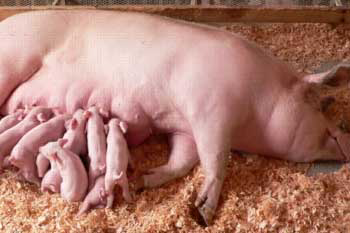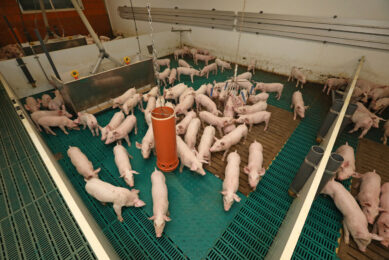Many factors affect sow performance at second litter

Raising and managing successful sow herds comes with great responsibility and success is dependent on many factors. It pays to know that good performance can be achieved by paying attention to proper gilt rearing as well as reducing weight loss during the first lactation.
By Dr Lia Hoving, technology application specialist, Cargill
Around 19% of the reproductive sows in a herd are second parity sows, i.e sows after first weaning. Their reproductive performance – farrowing rate and litter size – therefore has a large impact on farm productivity. In general, reproductive performance is supposed to increase with increasing parity, reaching the highest level from parity 3 to 5. Many sows, however, show an equal or lower litter size in second parity than in first parity, which negatively influences reproductive efficiency of second parity sows and thereby farm productivity.
In modern pig production, however, a distinction between second parity sows and the rest of the reproductive herd is hardly made. Increasingly much is expected from all gilts and sows on a farm; during the past decade litter size and number of piglets weaned have increased, as shown in Figure 1. As a result, metabolic demands of sows have increased dramatically. Not meeting these could result in weight loss during lactation.
In general, a weight loss of up to 10-13% is considered acceptable, providing that there is room to recover during early gestation.
On top of this, the effects on litter size can be seen in the next parity performance and even in the rest of a sow’s reproductive life.
Going back to second-parity sows – as they need to recover from their first lactation, they are relatively more at risk in comparison to higher-parity sows. They can do with some extra attention.
Preventing weight loss
Increasing sow feed intake during lactation seems to be the most obvious solution to preventing weight loss in the first lactation. However, in many cases this is not as easy as it seems.
One common pitfall is the availability of sufficient clean fresh water. Feed intake and water intake go hand in hand, i.e. if water is limited, then feed intake will suffer. The drinking nipple should supply each sow with around 2-2.5 litres of water a minute in order to ensure sufficient water intake. It pays to regularly check the drinking nipples as well as water quality.
Secondly, the temperature in the farrowing room should be optimised. Room temperatures in farrowing rooms are often around 23-24°C, which is optimum for piglet survival. Sow feed intake, however, is negatively affected by these high temperatures. Sow feed intake decreases by 170 g with every degree increase in environmental temperature above 16°C. This means that the feed intake is reduced by about 1.1 kg in a room of 23°C when compared with a room temperature of 16°C.
Making insulated and warm piglet nests enables producers to reduce the farrowing room temperature to about 18 to 20°C without affecting piglet survival. In hot climates sow cooling systems, such as drip or snout cooling, can also be used to increase sow feed intake. Furthermore, sow rations could be more concentrated and could be formulated with compounds that produce the least amount of internal heat when digested. However, this also increases the risk of mastitis, metritis and agalactia (MMA) when the transition from gestation does not go smoothly.
Another way to decrease weight loss during lactation is to decrease the lactation burden of sows. This can be done by either split suckling, taking half the litter from the sow around three weeks of age, or intermitted suckling, separating the sow and piglets for several hours per day. Both methods, however, have shown variable results and therefore are not advised.
Creep feeding piglet with (liquid) prestarter has also been shown to have positive effects on sow weight loss during lactation. This was shown in a field trial by Provimi.
One further option is to reduce the lactation length, but this route may be limited by animal welfare regulations. Alternatively, the number of piglets suckling can be decreased or piglets can be creep fed.
Gilt development
Well-developed gilts are better able to resist lactation weight losses and show a better performance throughout the lactation compared with less developed gilts. A group of researchers associated with Dr Emma Clowes at the University of Alberta, Canada, showed in 2003 that heavier gilts at the start of lactation (193 kg vs 165 kg, excluding piglets) had more follicles of 3.5 mm or larger when compared to lighter gilts, as shown in Figure 2.
A different study showed that gilts with larger follicles at weaning will probably have a reduced weaning to oestrus interval and stronger signs of oestrus. Furthermore, well-developed gilts are more likely to have better feed intakes during the lactation than less-developed gilts.
As well as farrowing weight of the gilt, her weight gain from first insemination to first weaning, including lactation weight loss, might also influence reproductive performance in her second and subsequent parities. This is shown in Figure 3 where gilts with a higher weight gain in the first cycle had, on average, a higher farrowing rate compared with gilts with a lower weight gain during the same period.
First insemination
The commonly used target is 140 kg bodyweight at first insemination which is at the second oestrus during puberty. Gilts should then weigh between 180 kg and 190 kg at farrowing, excluding piglets. The age at which the gilt achieves the 140 kg will vary between breeds, husbandry systems and countries, but it is typically between 210 and 240 days.
Besides weight at first insemination, back fat depth should be taken into account since gilts that are too fat at farrowing can give problems throughout their reproductive life. Gilt rearing should therefore focus on optimising weight and back fat development. A specific rearing diet should be used in preference to a finishing diet.
In conclusion, management should be designed to avoid weight losses in sows during their first lactation above 10-13% as this has been shown to have a negative effect on embryonic survival, litter size and farrowing rate. Several management strategies are available to reduce lactation weight loss, one of them being ensuring a well-developed gilt at farrowing. Gilt development should therefore be optimised as well developed gilts are better able to cope with lactation losses. This might improve litter sizes of second parity sows, as well as subsequent parities.
Management of sows during their first lactation will also influence second parity performance. Special attention should be paid to sow nutrition and water availability, farrowing house temperature and piglet management.
References available on request.
Symposium on young piglet nutrition
In November 2013, Dr Hoving was one of the speakers at the Provimi Animal Nutrition Seminar 2013, held in Barcelona, Spain. In a joint presentation with Prof Bas Kemp, Wageningen University, the Netherlands, they touched on the theme of reducing within litter birth weight variation as well as how to learn to eat like piglets. This last topic was described in Pig Progress in late 2011. The key theme at the swine programme at the symposium was the use of prestarters – and how this affects pig performance in later life. Speakers included Prof Dr Georg Dusel, University of Applied Sciences, Bingen, Germany; Dr Ruurd Zijlstra, University of Alberta, Canada; Dr Simon Tibble, global species technology specialist, swine, Cargill; and Dr Douglas Cook, Cargill. The symposium also had a general programme, focusing on how to combine ‘sustainability’ with ‘food security’ in 2050. This programme featured speakers like Todd B. Hall, Cargill corporate vice president; Dr Martin Scholten, Wageningen University, the Netherlands, and Dr Marty Matlock, University of Arkansas, USA.
Source: Pig Progress magazine Vol 29 nr 10, 2013











